Easy Buckwheat Sourdough Bread
This post may contain affiliate links. As an Amazon Associate, I earn from qualifying purchases. Please read my disclosure.My amazing buckwheat sourdough bread is soft, fluffy, and loaded with healthy nutrients. Great for anyone trying to achieve bakery-style bread at home, my recipe requires just 7 simple ingredients and is so easy to make! With just a few simple steps, even first time bread makers will feel confident making this foolproof buckwheat sourdough recipe.

I have always had a soft spot in my heart for homemade bread. Sure, you can grab a loaf of bread at the grocery store but nothing beats homemade freshly-baked sourdough bread right out of the oven. Just the glorious smells bring me right back to my childhood and make me feel at home.
Yet, many people think of baking bread from scratch as a daunting task reserved only for the pros, but this couldn’t be further from the truth. My unbelievable sourdough buckwheat bread recipe requires just 10 minutes of prep time and under an hour in the oven before it’s baked to fluffy perfection.
In my house, this bread tends to disappear quickly. Toasted it’s a fantastic healthy breakfast idea for kids too!
👩🏽🍳 Why I Love This Recipe
If you’ve ever wondered “Can you make sourdough bread with buckwheat flour?” The answer is a resounding yes and you’ve seriously been missing out. I’ve tested this recipe countless times and I love how this sourdough with buckwheat has an irresistibly soft, fluffy interior with a perfectly chewy, crusty exterior.
Not to mention, buckwheat flour is a superstar in the health food world that starts out as raw buckwheat groats – a nutrient-dense ancient grain (source) known for its nutty, earthy flavor. It is often ground into a fine flour that can be transformed into baked goods like this fabulous buckwheat flour sourdough.
The use of a Dutch oven simplifies the baking process, making it possible to bake this bread in under an hour. I have found that it’s a fun and easy introduction to bread making for both beginners and even kids.
By baking at home, you save on the markup and get to enjoy a bakery-quality loaf without the high price tag. The key ingredients – buckwheat, all-purpose, and whole wheat flour are affordable and easy to find.
While this particular recipe of mine is not naturally gluten-free, I do have a gluten-free buckwheat bread recipe that is also equally delicious! And this buckwheat sourdough bread recipe is naturally vegan and can also be turned into a gluten free bread recipe with a few simple swaps.
Latest Recipe Video!
✔️ Baking With Buckwheat Flour
Despite its name, buckwheat flour contains no wheat at all. It’s a completely gluten-free flour made by grinding whole buckwheat groats into a fine powder. It adds a nutty, earthy taste to baked goods and gives my buckwheat sourdough its deep flavor and slight bitterness.
However, due to its gluten-free nature, when making sourdough bread, I like to blend buckwheat flour with other flours that contain gluten, like all-purpose or whole wheat flour. This mix is my secret to achieving the perfect texture and flavor. With my recipe, you get the fantastic flavor of buckwheat along with the soft, fluffy texture we all love. It’s the best of both worlds!
🙋🏽♀️ What Is Sourdough Starter?
The heart and soul of any sourdough bread begins with a sourdough starter, which is a living mixture of flour and water that captures wild yeast and beneficial bacteria from the air. This magical combination is what gives sourdough bread its signature tangy flavor and irresistible texture.
You can find sourdough starter at health food stores or local bakeries. You can also easily make sourdough starter at home by mixing equal parts of flour and water and letting it sit at room temperature for about a week until it’s bubbly and active.
Each day, you need to “feed” it with a little more flour and water to encourage the growth of the natural yeast and bacteria, but the process is simple. To save time with this recipe, I used store-bought sourdough starter, but it will work with any starter you have!
🥘 Ingredients
One of my favorite things about this sourdough buckwheat bread recipe is that you only need 7 basic ingredients. The best part is that you probably already have most of them in your pantry at home! Check out the recipe card below for the exact quantities needed.

Whole Grain Buckwheat Flour: You can find buckwheat flour at most grocery stores where you would find other alternative bread flours like brown rice flour, millet flour, and oat flour. If you want to make your own flour using whole-grain buckwheat groats, simply toss them into a food processor or blender and pulse until a fine flour forms. (Learn More: How To Cook Buckwheat).
All-Purpose Flour: To ensure that my buckwheat sourdough is fluffy rather than dense, I use a combination of buckwheat and all-purpose flour or gluten-free flour. I’ve done lots of recipe testing to come up with the ideal ratio, so I don’t recommend turning this into a 100% buckwheat sourdough bread recipe. You can trust that this is the perfect combination.
Whole Wheat Flour: While you could simply combine buckwheat and all-purpose flour, I like to add whole-wheat flour into the mix for added whole grains. By using both regular all-purpose flour and whole-grain flour, you wind up with bread that tastes amazing and is packed with fiber and other beneficial nutrients.
Sourdough Starter: A fermented dough made with wild yeast and lactobacilli, sourdough starter is essential for making any sourdough bread recipe rise. You can often find it at health food stores and bakeries, but many people choose to make their own sourdough starter instead. Feel free to use a gluten-free sourdough starter if desired.
Coconut Sugar: You only need a small amount of coconut sugar to enhance the natural flavors of this sourdough bread with buckwheat flour. If you can’t find coconut sugar or want to try something else, you can use maple syrup or brown sugar instead.
Salt: Just a pinch of salt enhances the flavors of the other ingredients.
Warm Water: Simple water activates the sourdough starter and brings the dough together. It’s crucial that you use warm water for the most delicious homemade bread.
🔪 How To Make Buckwheat Sourdough Bread
Learning how to make this whole-grain buckwheat flour sourdough bread recipe is really easy! My instructions break it down into easy steps and you only need a few hours to let the dough rise, and under an hour in the oven!
Watch my video below to see how effortlessly this bread recipe comes together.
Whisk Dry Ingredients: In a medium bowl, whisk together the buckwheat flour, all-purpose flour, whole wheat flour, sugar, and salt.
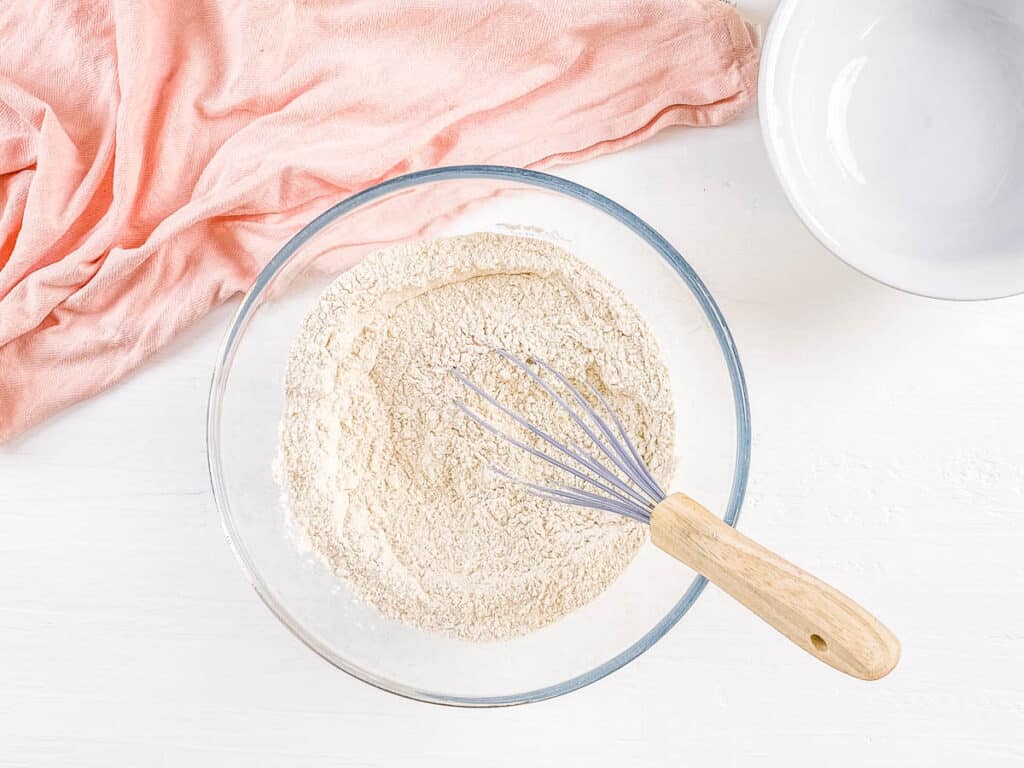
Form Dough: Then I add the sourdough starter and 1 cup of warm water to the dry ingredients, and mix until combined well. Add the remaining water and mix until well incorporated.
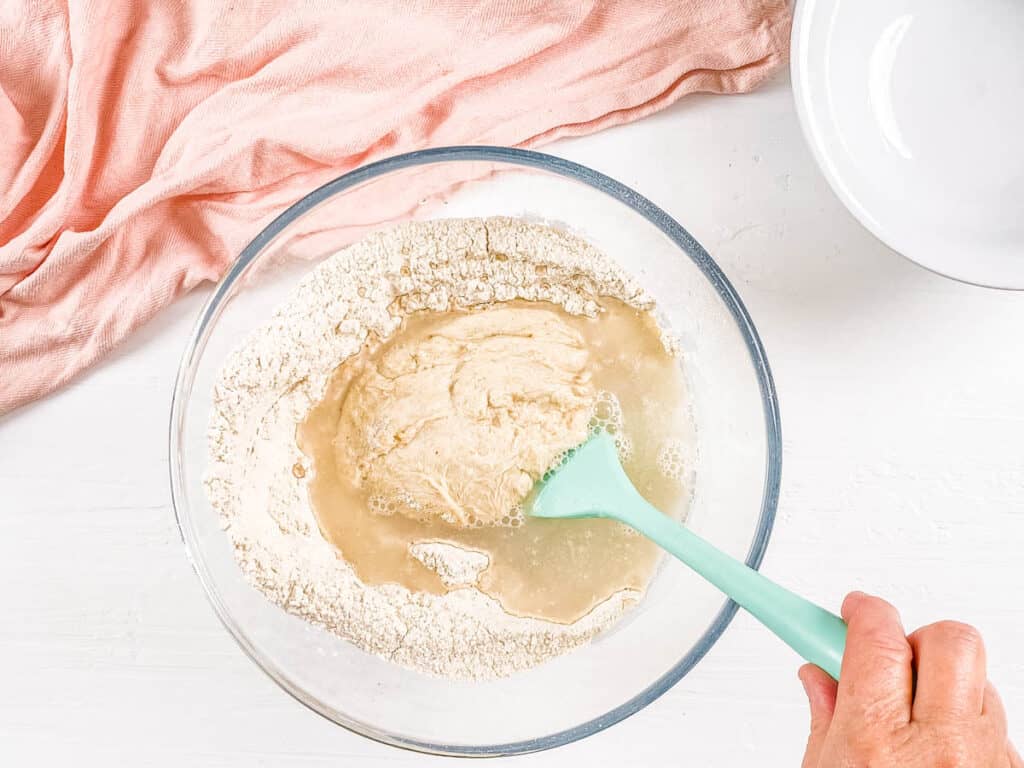
Knead Dough: Knead the dough on a floured surface until smooth.
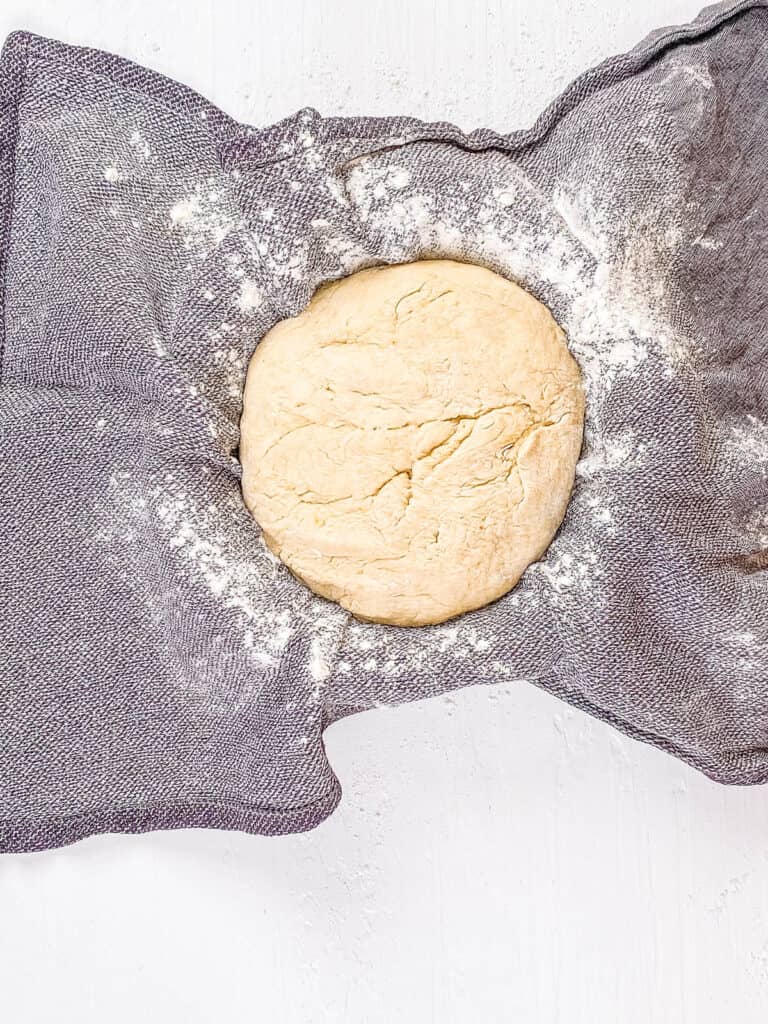
Let Dough Rest: To rest the dough, I’ll line a large bowl with a clean tea towel and dust with a sprinkle of flour. Place the bread dough into the bowl and cover. Rest in a warm place for 2 to 4 hours to allow the dough to rise slightly.
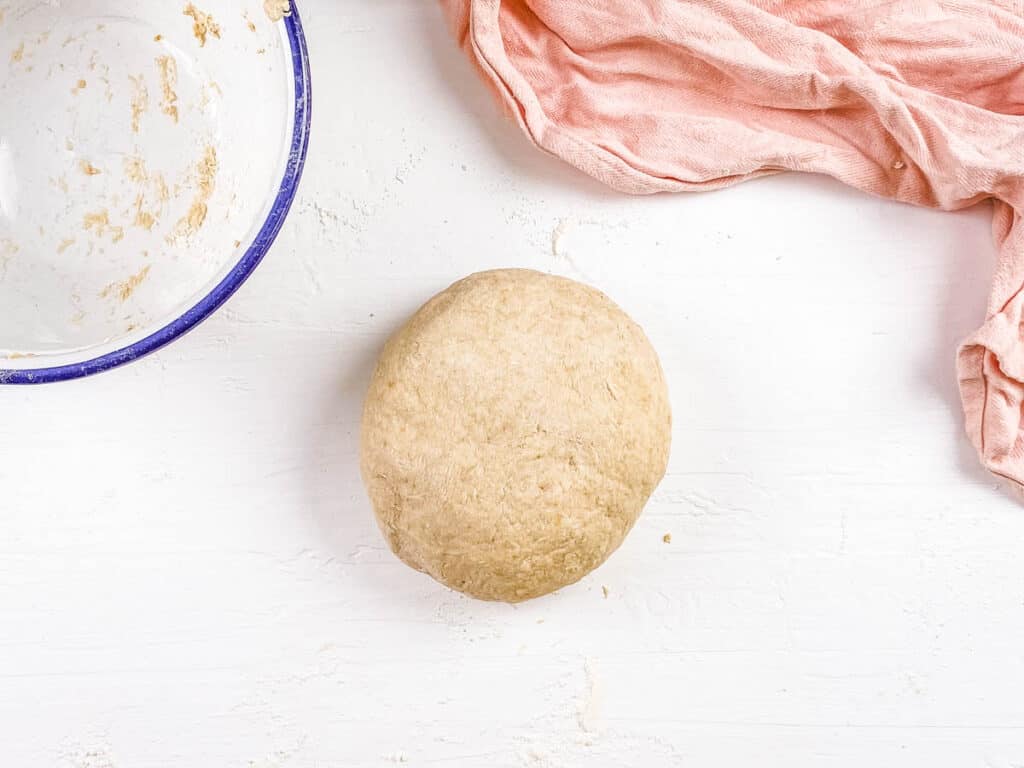
Preheat Oven: Preheat your oven to 400 degrees Fahrenheit (176 degrees Celsius) with the Dutch oven inside for 20 minutes before cooking the bread.
Prep Dough to Bake: After the dough has rested for at least 2 hours, uncover the top of the dough and place a piece of parchment paper over it. Gently turn the bowl upside down to remove the dough onto your work surface. I recommend scoring the dough with a sharp knife or a bread lame.
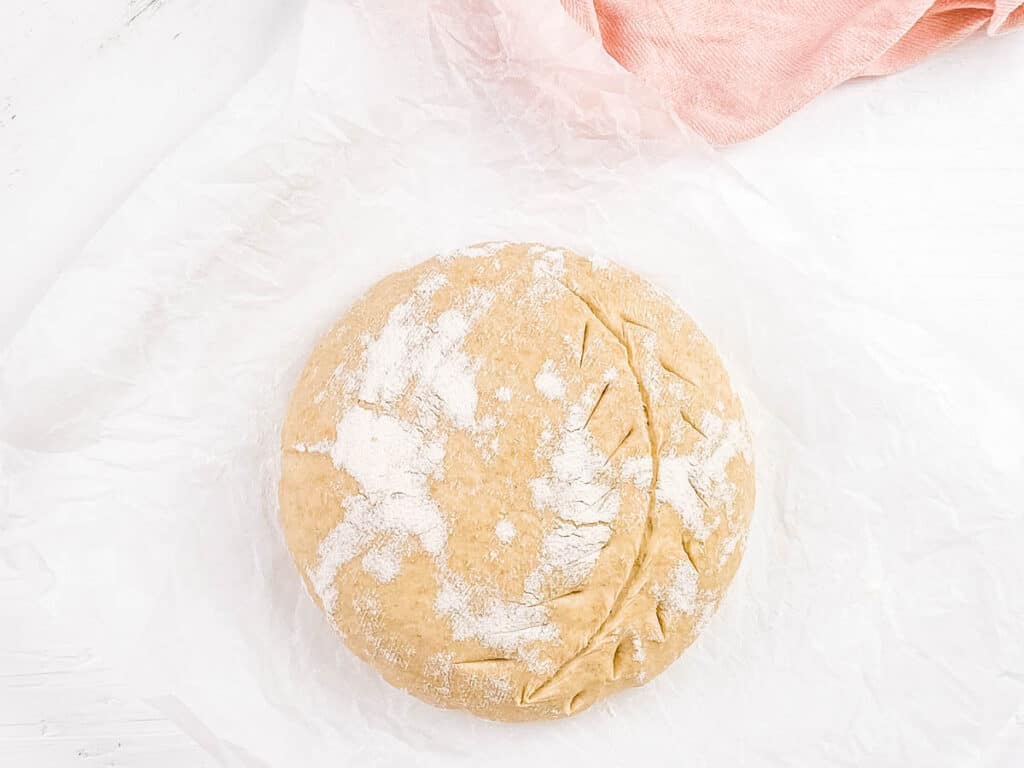
Bake Bread: Once the dough has been scored, I’ll place the dough into the hot Dutch oven, cover it with the lid, and cook for 20 minutes. Then I’ll remove the cover and cook for another 25 minutes. The last step is to finish cooking for another 10 minutes either directly on the shelf rails or a baking tray. The sourdough bread should be ready when it sounds hollow when tapped and the outside is crusty.
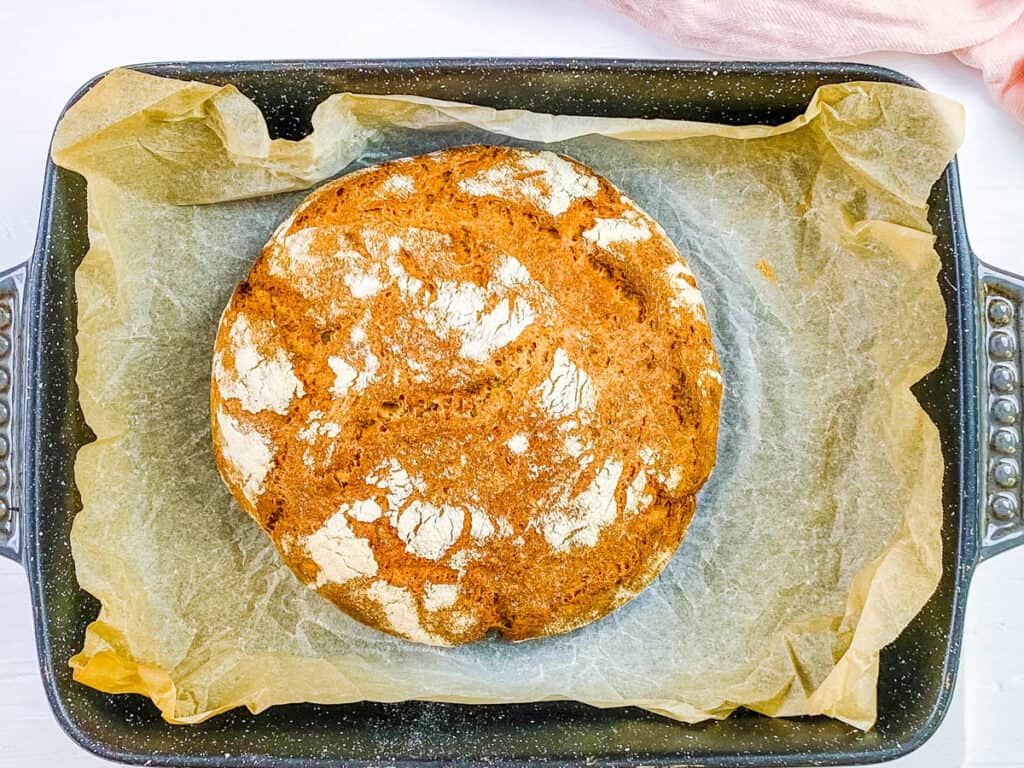
Slice And Serve: Let the loaf cool on a cooling rack for a few hours, until cooled completely . If I’m baking the bread in the evening, I’ll even let it cool overnight. Once cooled completely, slice and enjoy.
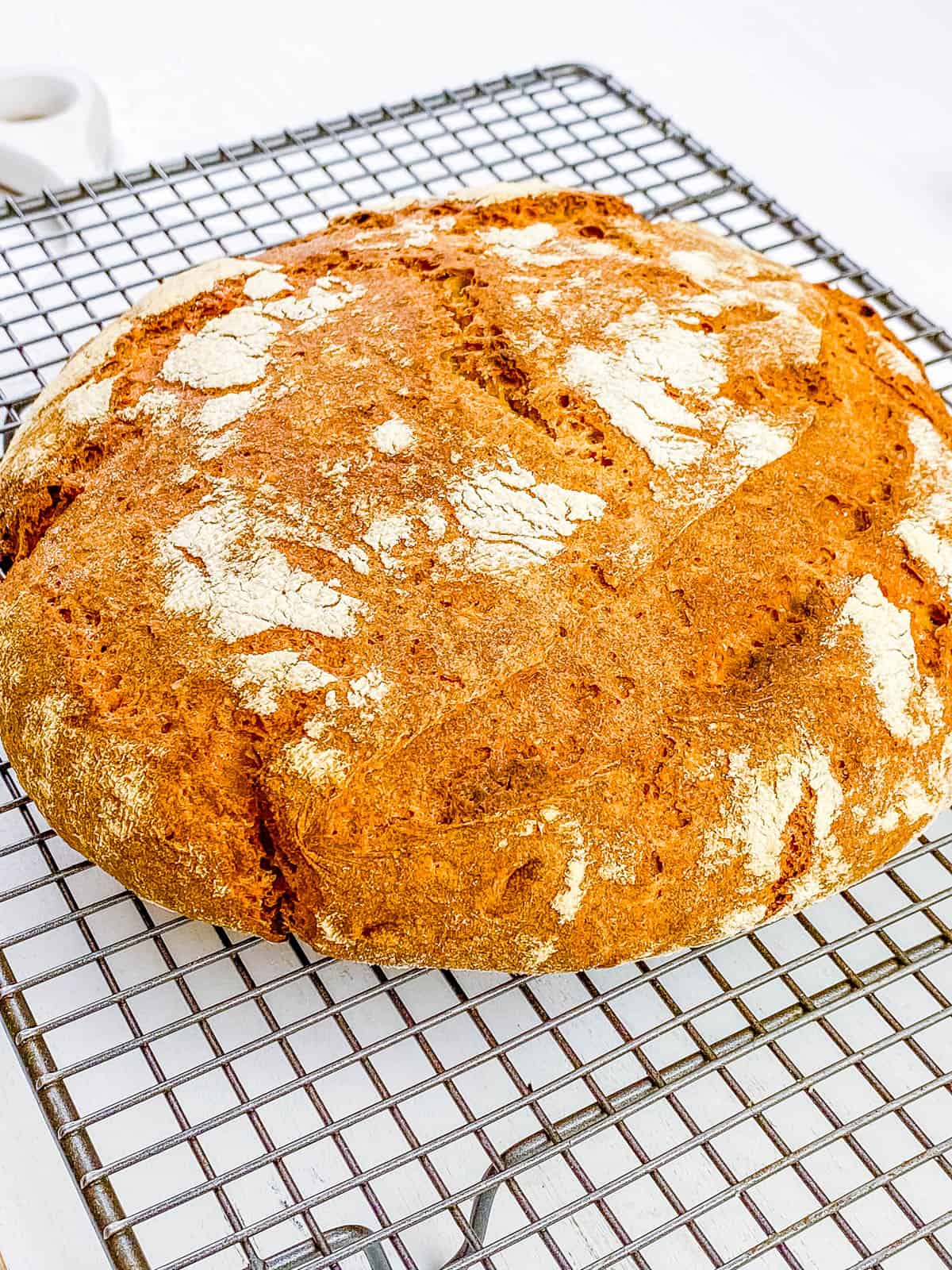
💭 Expert Tips
My #1 Secret Tip for this buckwheat bread recipe is to ensure your sourdough starter is active before beginning. An active starter is the secret to getting that perfect rise and sour tang that makes this bread so special. For those new to sourdough, I recommend testing your starter before you use it. To do so, you can drop a spoonful of your starter into a glass of water and if it floats it’s good to go.
Below are some more helpful tips, and since bread making is really more of an art than a science, I’ve also included a section on troubleshooting tips so you can get the ideal texture and taste every time.
Other Tips To Keep In Mind:
- Don’t have a Dutch oven? No problem, you can simply use a large baking dish or loaf pan and cover it with foil.
- Cooking times may vary based on the appliance used, so adjust as needed depending on what you are cooking with.
- A proofing basket also works: Feel free to use a cloth-lined banneton proofing basket instead of a bowl when shaping the dough.
⏩ Troubleshooting
My recipe is tried and true but things can sometimes go wrong. It’s part of the fun of baking. These are some common issues that sometimes happen to even the most experienced bakers, and my tips on how to solve them!
Bread Didn’t Rise
Solution: Make sure your sourdough starter is active and bubbly before you begin. It’s also important to proof your dough in a warm environment and extend the proofing time if needed.
Bread Is Heavy And Dense
Solution: The dough was most likely too dry. Try adding a bit more water and kneading the dough adequately to incorporate air. Balancing the buckwheat flour with all-purpose or whole wheat flour is crucial for a lighter texture.
Crust Is Too Hard
Solution: Your oven temperature was probably too high or the loaf was overbaked. Cover the bread with a damp cloth while it cools.
Bread Is Gummy Inside
Solution: Ensure your bread is baked thoroughly. If the crust browns too quickly while the inside remains undercooked, lower the oven temperature and bake longer. You can use an instant-read thermometer; the internal temperature should be around 200-210 degrees Fahrenheit.
Uneven Texture With Large Holes
Solution: It’s important that you mix the dough thoroughly to distribute the ingredients evenly. Proper kneading is needed to develop a uniform structure.
📖 Variations
There are plenty of tasty ways to customize this buckwheat sourdough loaf and make it your own. Below are some of my favorite options to try out!
- Toppings: You can jazz it up with some savory toppings like rolled oats, whole buckwheat, pumpkin seed butter, sesame seeds, or flaky sea salt.
- Gluten Free Buckwheat Sourdough Bread: You can easily turn this recipe into gluten-free bread by swapping out the all-purpose flour and whole-wheat flour with gluten-free flour. Make sure to also use a gluten-free starter.
- Spelt and Buckwheat Sourdough: Spelt flour is light and airy with nutty flavors and a subtle sweetness. If you want to add it to this recipe, you can use it in place of the whole-wheat flour.
- Rye Buckwheat Sourdough: Rye is incredibly nutrient-dense, so it would make a great addition to this recipe. I wouldn’t recommend using it to replace the all-purpose flour, but you can use it instead of whole-wheat flour or use equal parts of both.
Recipe Adaptation Chart
It’s important to understand some of the science behind baking whenever you make changes to a recipe. When making bread, the general rule of thumb is that the total weight of the flour needs to stay the same.
For example, if you want to make my recipe gluten-free, you would need to replace the all-purpose flour and whole wheat flour with 2½ cups of gluten-free 1:1 flour. Using more or less flour will throw off the recipe.
As you can see in this chart, the total amount of flour should add up to 100%. You may need to adjust the water slightly depending on the combinations of flours you choose. By keeping this rule in mind, you can experiment with the ingredients and make a delicious loaf every time.
| Ingredient | Volume | Baker’s Percentage |
|---|---|---|
| Buckwheat Flour | ¾ cup | 23% |
| All-Purpose Flour | 1½ cup | 46% |
| Whole Wheat Flour | 1 cup | 31% |
🍽 Serving Suggestions
I love serving this buckwheat sourdough bread fresh from the oven with an oatmilk honey latte, but this bread can go far beyond a simple slice. Here are some of my favorite ways to use it.
With Spreads: Try slathering it with mashed avocado, nut butter, cream cheese, my butter bean hummus, fruit compote, and vegan Nutella.
Make Sandwiches: Use it to make your favorite sandwiches. Some of my favorites are Mediterranean veggie sandwiches, vegan egg salad sandwiches, and PBJ for the kids.
Alongside Soup: I will often pair this bread with a bowl of warm and comforting soup for a complete meal. Fresh sourdough buckwheat bread is yummy with any soup and especially amazing with my vegan minestrone soup or pinto bean soup.
For Breakfast: You can serve it as toast with this hearty silken tofu scramble, use it to make eggs in a basket, or better yet make my yummy, indulgent vegan french toast casserole!
🧊 Storage And Reheating
I like to store my freshly baked loaf of bread at room temperature for up to 3 to 4 days. It’s best when enjoyed during the first couple of days, but you can also freeze your bread to preserve it for longer if needed.
To Freeze: Make sure to let the bread cool completely, and slice it before transferring it to an airtight container or plastic bag. Freeze for up to 2-3 months.
To Reheat: Warm slices individually in the toaster or toaster oven on low until just warmed through and toasted to your liking.
❓Recipe FAQs
Kneading the dough until it’s smooth and elastic is key. This usually takes me around 8-10 minutes of kneading by hand. You can also use the windowpane test: stretch a small piece of dough between your fingers; if it stretches without tearing, it’s ready.
If the dough is too sticky, add a little more all-purpose flour. If it’s too dry and crumbly, add a few teaspoons of warm water until it becomes pliable and smooth.
Scoring helps control its expansion during baking and gives it an attractive appearance. It also allows steam to escape, resulting in a better rise and texture.
The bread is done when it has a deep golden-brown crust and sounds hollow when tapped on the bottom. If unsure, I recommend using an instant-read thermometer; the internal temperature should be around 200-210 degrees Fahrenheit (93-99 degrees Celsius).
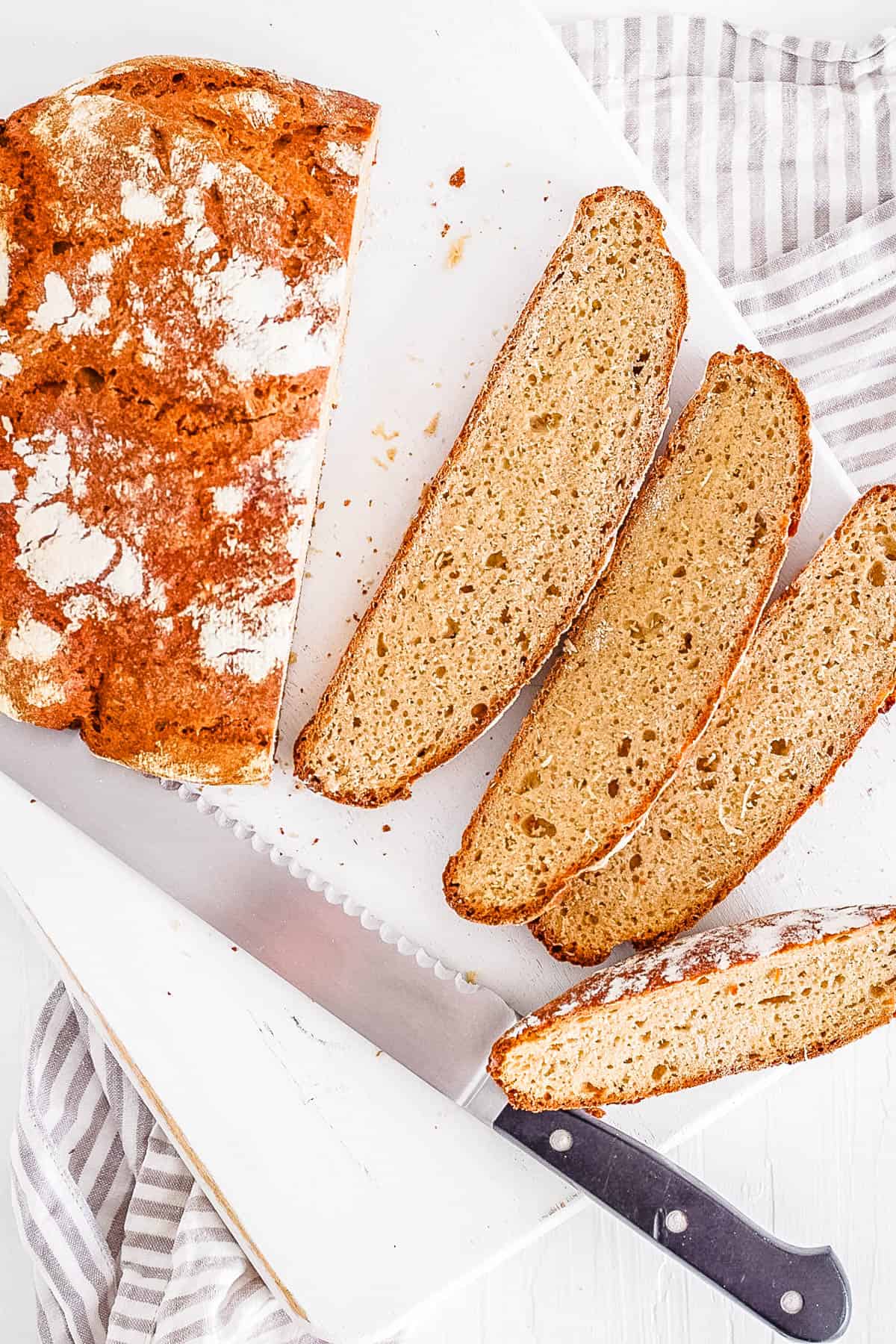
Love this vegan recipe? Please leave a 5-star rating 🌟 in the recipe below and/or a review in the comment section further down the page!
You can also FOLLOW ME on FACEBOOK, INSTAGRAM, and PINTEREST to see more delicious, healthy, family-friendly food, and if you have any questions, I’m here to help!
📋 Recipe Card
🎥 Watch How to Make It
Buckwheat Sourdough Bread
Ingredients
- ¾ cup Buckwheat
- 1½ cups All-Purpose Flour
- 1 cup Whole Wheat Flour
- 1 tbsp Coconut Sugar
- 1 tsp Salt
- 1 cup Sourdough Starter
- 1¼ cups Warm Water
Equipment
Instructions
- In a medium mixing bowl whisk together the flours, sugar and salt.
- To the dry ingredients add the sourdough starter and 1 cup warm water. Mix until combined well.
- Add the remaining water, mix until well incorporated.
- Knead dough until smooth.
- Line a bowl with a clean tea towel and dust with a sprinkle of flour. Place the dough into the bowl and cover.
- Rest in a warm place for 2-4 hours to allow the dough to rise slightly.
- Heat the oven to 400 degrees F / 200 C, along with a dutch oven for 20 minutes before cooking the bread.
- After the dough has rested for at least 2 hours, uncover the top of the dough and place a piece of baking paper over it. Gently turn the bowl upside down to remove the dough. Score the dough with a sharp knife or a bread lame.
- Place the dough into the hot dutch oven, cover and cook for 20 minutes. Remove the cover and cook for another 25 minutes.
- Finish cooking for another 10 minutes either directly on the shelf rails or on a baking tray.
- The sourdough bread should be ready when it sounds hollow when tapped and the outside is crusty.
- Let the loaf cool on a cooling rack for a few hours, or overnight. Once cooled completely, slice and enjoy.
Notes
- If you do not have a dutch oven simply use a large baking dish and cover with foil.
- The sourdough starter that is used must be ripe to ensure a lovely fluffy loaf of bread.
- Cooking times may vary based on the appliance used.
- A cloth lined banneton basket can be used instead of a bowl when shaping the dough.
- This bread is best enjoyed within 2 days. Leftover bread can be sliced and frozen for up to 2-3 months.
- To make this bread gluten free substitute the all purpose and whole wheat flours for gluten free flour and make sure to use a gluten free sourdough starter.






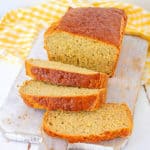


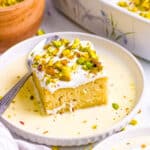


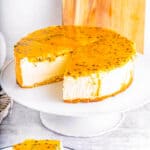







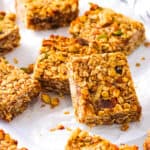



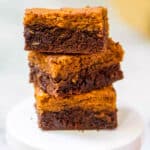








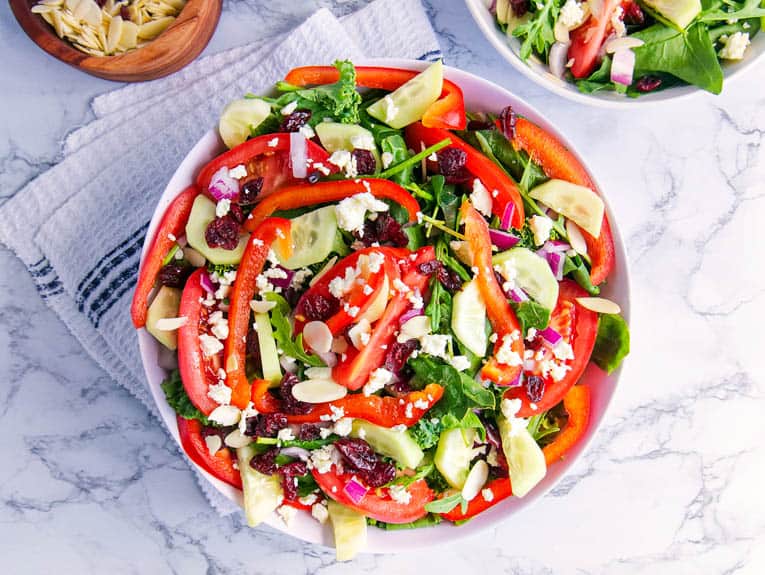


Thank you! I am so excited to try this recipe. I love all of the details, variation, etc, that you have provided.
Thanks Lois! I can’t wait to hear how it turns out for you!
I love baking with starter, this is a lovely and quick bread recipe that anyone can bake up!
Thanks so much Heather! 🙂
I love sourdough but never had the confidence to make it. But with your recipe, I’m going to give it a try this weekend!
Yay! So happy to hear that – enjoy!
I love experimenting with my sourdough, but I’ve never thought of adding buckwheat flour! Thank you so much for this thorough post, I can’t wait to try it!
I can’t wait for you to try this recipe – you’ll have to let me know how it turns out!
I can’t wait to try this recipe! I love that there are only 7 ingredients.
Thanks Ashley! You will love it!
I have been looking for a great gluten free buckwheat sourdough recipe and this is it!!! So soft and fluffy yet crusty. Thank you so much. This is a dream recipe!
Aw thank you so much Kay! I’m so happy to hear that! 🙂
Hi, I’ve made quite a lot of SD bread recipes but they typically ferment overnight…….is there any reason I can’t let this ferment for much longer than the 2 hours?
Hi Sandy! In my recipe I mention letting it ferment for at least 2 hours (at a minimum 2 hours) – you could absolutely let it ferment for much longer, overnight should be fine! Hope that helps clarify!
I’m still new to sourdough baking and I’m wondering… is the sugar absolutely necessary? We’re trying to reduce glycemic spike as much as possible. I wonder if it is added for flavor or if it is needed for the fermentation? Thank you!
Hi Hilary! While it’s not 100% necessary, the sugar does play an active role in this recipe in a few ways:
1) It helps with the overall rise of the bread and the rising time
2) It tenderizes the crumb, so it helps make the bread softer
3) It increases the browning of the crust
You can certainly try this without sugar and it will probably still turn out ok, but it may not taste as soft / light as it would with the sugar! Hope that helps!
I am out of bread, so it is time to get to cooking. This sourdough bread is amazing!
Awesome! I know you’ll love this recipe Mahy!
If it’s really like you said beginner-friendly, I will make! I am not so good with baking goods and bread is kinda intimidating. I’ll let you know if it came out as great as yours 🙂
Yes!! I can’t wait for you to try it – let me know how it turns out! 🙂
I’m not very confident making sourdough bread but just reading through your recipe I am looking forward to giving it a try.
This is a great recipe for beginner bread bakers Charla! I’m sure it will turn out great – keep me posted on how it goes!
I love making sourdough, but it was the first time I made one with buckwheat. It gave the bread such a lovely deep earthy flavour. Almost nutty! Really enjoyed it! Thanks!
Awesome! So happy to hear that Ieva!
This bread looks amazing. I am a big fan of buckwheat and the recipe looks so easy too.
Thanks Amanda!! I know you will love this recipe, and it really is so easy to make!